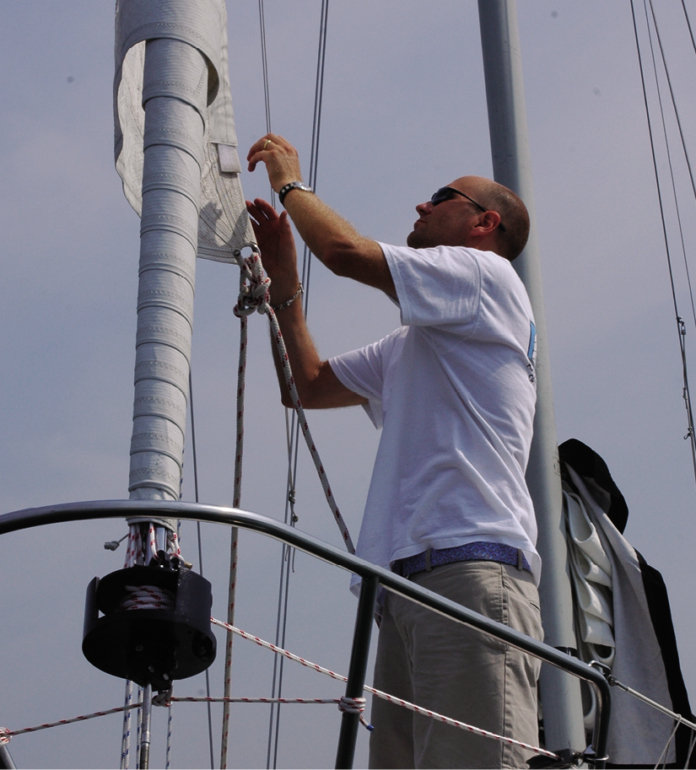
ALADO FURLER ISSUES?
My Alado furler system was installed for 3 years on my Newport 27 and the 3/16” forestay (purchased separately at the same time) snapped near the top of the bottom turnbuckle while under way. The fact that the system contains its own halyard system is not more advanced that the other systems that use a masthead forestay. Since the system is essentially floating on your forestay, the lateral weight caused by furling and winds on the jib are being forced upon the fittings at the top of the mast and right above the turnbuckle on the bow. On conventional furling systems the masthead halyard tightens the luff tape on the jib which helps to take some of the side loading. Stainless steel is strong when tensioned, but can break like a paperclip under constant side loads, which is exactly what happened to mine. Luckily everyone on the boat was safe and I was able to recover everything. I will not be reinstalling the Alado system.
Kevin Cerini
Kissimmee Kate, Newport 27
San Francisco, CA
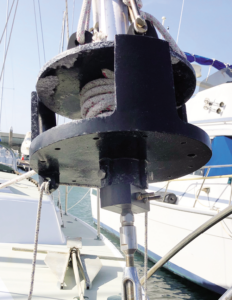
As you point out, Alado’s integral halyard design has its drawbacks (see “PS Tests the Alado Jib Furler,” PS December 2008), but it offers an affordable alternative to conventional designs and a few advantages to the DIY installer. Integral halyard furlers like the Alado and CDI have a long history of use, particularly on boats in the under 35-foot range—but we’d look at more conventional designs for more rigorous offshore work. The furler we installed for our report never gave us a problem over six years of testing but your experience raises questions. As you mention, the integral halyard setup means the halyard/luff tape does not relieve headstay tension as it does on a conventional furler. In our experience, as long as there is adequate backstay tension, properly sized hardware, and free movement in the toggles and turnbuckles, the integral halyard design should not result in harmful side-loading. Several other factors may have contributed to the failure, including fatigue (which can happen at the dock), corrosion (often invisible), or a material defect. Clean breaks near the terminal like the one you describe also occurred our straight-pull testing of wire terminals, so side-loading isn’t the only possible culprit (see “Mechanical Terminal Pull Test,” PS April 2017). The chief advantage of the integral halyard system is that it can be installed fairly easily by the do-it-yourselfer—but the latest generation of conventional furlers have also simplified their installation (see “Genoa Furler Refit: a Semi-DIY Project,” PS October 2019). We would be interested in hearing about others’
experiences with furler systems like the Alado which feature integral halyards.
DIESEL FUEL LIFE?
When a boat is not used often, does the diesel fuel need re-treatment if no new fuel is added? I try to run my Perkins 4-108 once or twice a month, in gear at the dock at 1,200 RPM as my marine engine installer recommended. My 40-gallon tank lasts a very long time.
I am using StarTron additive, but uncertain whether additional treatment is needed periodically.
Phillip Legare
Via PS Online
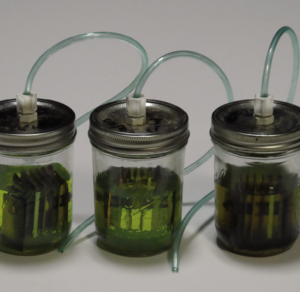
Properly stored, marine diesel can easily last five years without causing any harm to your engine. But too often on boats it is not properly stored. In our view, you should aim to completely cycle your tank every three years at a minimum, and make sure that you maintain good quality fuel through the use of biocides as needed. Regular filter changes should give you a good indication of fuel quality. During filter changes sample your fuel. It should be “clear and bright,” with no turbidity. Don’t worry about color. Most diesel is amber, but red dye is used in the U.S. to designate fuel that has not paid a road tax from which boats are exempt.
Your chief enemy is water in the diesel which allows bacteria to grow. In the U.S., where fuel is rarely contaminated and the blend is already dosed with stabilizers, leaks at the filler cap is often the culprit.
In short, keep water out, use biocides as needed, and monitor filters for signs of contamination. So long as your tank and lines are in good condition, your fuel will be good.
We’ve done extensive testing of diesel biocides and found several formulas that kill bugs and help prevent them from coming back, “Biocides Take on Contaminated Fuel,” PS July 2009. Fuel polishing, either through a dockside service or a built-in system, can get rid of bugs, but unless you treat the polished fuel with a biocide, they will return. If your tank has sat dormant for years, you might need a complete tank cleaning (see “Do-it-Yourself Tank Cleaning,” PS July 2018). Another concern is certain metals leaching into the fuel over time (see “Are Copper Zinc, and Brass Mucking Up Our Fuel?” PS December 2019). The additives we recommend help neutralize the offending metals, but as our study shows, the fittings and hoses you put in your fuel system should be rated for that purpose, and not just whatever you can find at the local hardware store.
If you really want to dive into the topic of fuel quality—both diesel and gas—our e-book “Marine Fuel Additives,” covers the topic from top to bottom (see https://www.practical-sailor.com/product/marine-fuel-additives).
PRAISE FOR THE CATALINA 22
I enjoyed your review of the Catalina 22. My parents got one in the mid-’70s and I “inherited” her. My wife and I spent our honeymoon cruise on her, later we packed our 3 kids and a dog on it for a 5-day cruise. I fixed her up again for a 25th anniversary honeymoon-reprise cruise. Not a fast boat, but to learn to sail and cruise? Perfect. And growing up cruising in such tight accommodations made the trimaran I have now gravitated towards (a reaction to sailing slowly?) quite tolerable. It is a perfect starter-boat. Mast-raising is easy if done carefully and slowly with appropriate gin-pole and some “baby-stay” guy wires: the trick is to get the baby-stays to rotate around the same point as the mast-base so they are tight all the way up. Or to have some help keeping the mast straight during raising.
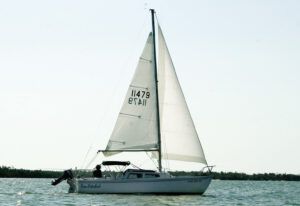
Your review of the Catalina 22 does focus on many negatives, but missed the wicked weather-helm under some conditions. It took me years to realize I could simply move the center-of-effort aft by raising the swing-keel some, which helped immensely, despite seeming counter-intuitive. Don’t be scared off, but on older boats inspect the plywood cores for saturation and rot, and check for signs of separation of the deck from the hull at the bow: I installed a turnbuckle from foredeck to the bow-ring to take the forestay tension when I fixed ours up.
My current boat is Corsair F-31 hull #001, registered in Ottawa, Canada. Most of our cruising has been on Georgian Bay, North Channel. We made one trip to the Bahamas. We bought Osprey largely because of features we loved about the Catalina: trailerable behind a (large) SUV, easy to launch, shallow draft (the F-31 is beachable), reasonable (if a bit tight) accommodations.
Ben Bacque
Osprey 007, Corsair F-31
Georgian Bay, Canada
WALKER BAY PARTS PROBLEMS
I bought a Walker Bay 8 with sail kit last year and the holes to install the drain plug were mis-drilled, requiring me to redrill them. Worse, the rivets holding the plastic plugs in the top and bottom of the daggerboard had not been made flush. Fortunately, I found this out using the short plug instead, because it took two full grown adults using a screwdriver and a 2×4 as a lever to remove the plug. Having realized that the 8-foot model was too small for me (I’m not as limber as I used to be) I ordered a Walker Bay 10. The boat arrived missing a number of bolts for the thwarts. The dealer I ordered through was told that the sail kit was missing pieces. The Walker Bay 8 and 10 are both fine boats, but I suggest buying one used.
J. Greely
via PS Online
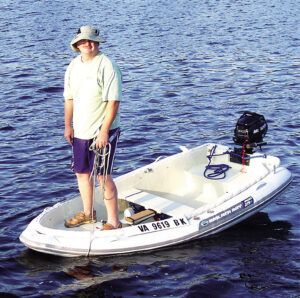
buoyancy and stability of the RID design, which
features an inflatable collar.
Walker Bay took the dinghy market by storm with its injection-moulded polypropylene hull a few decades ago. Product support was one of its calling cards. We’d be interested to hear if other Walker Bay owners have experienced similar problems.
PUMP NOISE
I have a new to me Catalina 42 with a loud fresh water pump. It is mounted with rubberized mount. It is located in a relatively spacious behind the engine compartment. Can I ‘wrap’ the pump in the insulation you recommend?
Rick Benson
Catalina 42
Via PS Online
Just wrapping a mechanical device with insulation can do more harm than good as it could lead to overheating. Try to isolate the source of noises—friction (whines, squeaks, hums) or vibration (which you should feel near the mounting area and adjacent structures). The former will benefit from strategically placed sound barriers, the latter can be fixed better mounts or by stiffening the fiberglass panel it is mounted on. Is the pump cycling too often because there is no accumulator/expansion tank? Some pump manufacturers are claiming “no accumulator/expansion tank needed,” but in the opinion of many engineers, this isn’t really viable for many systems, and it leads to disappointed owners. Boat builders like the on-demand pumps because they save time. If there is a hot water heater, there needs to be an expansion tank, period. Otherwise, the pipes have to absorb the expansion, eventually failing.
LEAVE BOTTOM JOBS TO THE PROS
Omitted from discussion was the use of chemical hazmat suits routinely worn by workers handling hazardous chemicals/paints in commercial and US Naval Shipyards. These suits have external filtered air supplies in addition to complete body coverage. They’re used routinely in the commercial shipbuilding and repair industry throughout the world. As well anywhere where hazardous materials are involved.
We might also note that in the early days of fiberglass boat building it was all too common for yard workers to wrap their heads with just a cloth or towel. Many of those workers subsequently came down with various cancers dying premature deaths. The materials rank high on the list for incidence of cancers. Painting, sanding, refurbishing boat bottoms ought be left to the properly suited professionals.
Peter I. Berman
Norwalk, CT
Via PS Online
Those early weeks of the “great splash,” when thousands of new boats hit the water for the first time this season can be chaotic to say the least. Whether you want to be first in the water or are happy to keep tinkering for a few more weeks, the PS Online archives have got you covered.
WOOD FINISH
Modern polymers have made the job of protecting wood easier, but we’ve also found some eco-friendly natural concoctions that provide limited protection as well. Search “wood finishes” with our online tool for a bucket-load of articles on products and application tips. The 2-year wood finish update (June 2021), and the application and gloss report (June 2015) provide comprehensive coverage and links to previous reports.
RIG INSPECTION
Winter’s freeze and thaw cycles can creep into rigging terminals, and hidden corrosion can leave your rig vulnerable. If you’ve not yet stepped your mast, inspection is easier. If you have stepped it, it’s time to climb. In any case, we have you covered. Search “rig inspection” at PS Online. The report “Hidden Causes of Rig Failure,” is a great place to start.
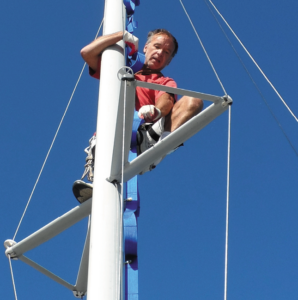
CLEANING
Still scrubbing? Check out our test reports on boat soaps (PS January 2013), waterline stain removers (PS April 2014 and November 2007), isinglass/clear-vinyl cleaners and protectors (PS May 2014 and March 2009), and hull waxes and polishes (Inside Practical Sailor blog April 9, 2014 and July 2014 PS issue). Our four-volume report on Marine Cleaners in the PS Online bookstore will ensure you’ve got everything you need (www.practical-sailor.com/products).

STORM READY
You don’t have to live in hurricane-prone area to benefit from our four-volume Hurricane Preparedness Guide (www.practical-sailor.com/product/hurricane-preparedness-guide-complete-series), which describes the gear and techniques that can help you ensure that your anchored, docked, or moored boat is in the best position to survive an extreme weather event.
In “Products and Tips to Stop Wood Rot” (see PS January 2021), we tested a number of anti-rot preparations, including a number of commercial borate products, plain borax, a DIY borate ester formulation, and Boracol 10RH. We noted that the only significant difference between Boracol 10RH and our DIY borate ester was that Boracol had benzalkonium chloride (BAC), an anti-mildew agent we had previously tested in low doses on carpet and fabrics.
The product performed well in our tests, and we included it among our recommended products. Prior to our testing, yacht manufacturer Hallberg Rassy had also endorsed its use for cleaning teak decks. New findings prompted us to change our view.
Sansin Chemical makes Boracol borate ester formulations both with and without BAC. The BAC formulations are not registered in the U.S. and are not sold here. The only formulation generally available retail in the U.S. is Boracol 20-2, which we do recommend.
Our research found that BAC can act as a solvent, and when used in high concentrations and allowed to soak into wood, it can cause minor deterioration of some sealants used in teak decks. BAC prolongs algae resistance, but not enough to outweigh the risk.
We still recommend BAC as an anti-fungal agent at appropriate dilution (0.1% for routine use and 0.2% for heavy duty cleaning of fabrics and carpet), but never at concentrations greater than 0.2%. This is 10-20 times weaker than the dilution in the Boracol blends. We do not recommend BAC for cleaning or maintaining teak. Here’s a breakdown of the various Boracal blends and our updated recommendations.
Products sold in the U.S.:
- Boracol 20, (no BAC, 20% borate). This product is recommended.
The following products containing BAC are available in Europe. Until we do further testing, we do not have enough information to recommended their use with teak decks:
- Boracol 5RH (2% BAC, 5% borate)
- Boracol 10-2BD (2% BAC, 10% borate)
- Boracol 10-3 BD (3% BAC, 10% borate)





































The much more likely cause of your forestay failure was due entirely to far too much forestay tension. The tension in a jib halyard is small compared to the tension normally applied to the forestay. The sheet tension applies a very small bending load to the forestay. The load in the sail is applied along the length of the forestay, which resists it by taking a catenary shape resulting in the load being taken entirely by tension in the forestay. The furling gear extrusion is relatively small diameter and therefore has low bending stiffness so it forms the same catenary shape as the forestay.
Having too much forestay tension, particularly if left fully tensioned constantly can lead to ‘stress corrosion’ and the most likely spot for this to occur is immediately above the lower swaged fitting. This is where sea water collects and concentrates and where there is additional stress caused by the swaging.
Having excess forestay tension has no benefit, the stay will still sag almost exactly as much but it will considerably hasten stay failure.
Another possible cause is too little forestay tension and lack of a toggle at the base of the forestay to allow it to pivot both fore-aft and laterally. This combination would result in a lot of repeated bending stress in everything from the turnbuckle lower jaw up, and you should check everything you are keeping for fatigue cracks (dye or Magnaflux tests by someone who knows how. If you did have a full range of motion there the break might have been caused by overtension, corrosion or fatigue.
I have a Simplicite furler on my 28′ boat, another “simple” system with integral halyard.
As near as I can tell, it’s been on the boat for 30 years, the 15 years that I’ve owned her, 12 years for the previous owner and near as the PO can remember, 3 or more years before that.
And it’s been fine all that time.
I do have some concerns about getting enough tension on the luff, meaning I probably don’t get the upwind performance I should. But it’s been completely reliable, and of course, there’s no masthead fouling issues.
I’d buy another such system without hesitation.